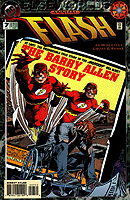

See Also: Facets, No Rules to Follow
After Wally West became Kid Flash, he became a teen heartthrob and media sensation, even starring in his own television series. But after Barry Allen’s death battling Captain Cold, Wally began losing his powers. His series began using special effects to simulate his lost speed, and eventually he lost the use of his legs altogether, confined to a wheelchair from then on.
Wally’s last moments with Barry were spent in a hospital room. Kid Flash had nearly been killed, and was recovering from frostbite, while Flash was on his last legs trying to shut down Captain Cold’s machine. Flash took Captain Cold with him to shut it down. He never returned. The machine exploded, the Flash trapped inside while Captain Cold survived in an escape pod. Wally never forgave himself for staying behind, and that guilt drove him to psychological paralysis.
A decade after Barry’s death, when Captain Cold wrote Speed Demon, a “no-holds-barred expose of the down-and-dirty side of the superhero business,” Wally decided to tell the “true” story of Barry Allen’s life and death so that the world would remember him as a great man, and not the twisted story told by Len Snart.
The story returns again and again to the hospital scene, filmed first melodramatically with Kid Flash out of the action not because he was sick, but because he had to deliver an organ for a transplant patient. Next, equally stilted from Captain Cold’s point of view, painting himself as misunderstood and the Flash as a fool who had caused the disaster himself. Finally, after confronting the lowest point in his life, Wally finds the will to get out of his wheelchair and film the true story—not the precise events, but the emotional core behind them. The resulting film is a success, launching a new career for Wally as (in Linda’s words) “the fastest director alive!”
Text by Kelson Vibber. Do not copy without permission. Primary Sources
Primary Sources
- “The Barry Allen Story” - Flash (second series) Annual 7 (1994), Mark Wheatley and Allan Gross
Notes
During the 1990s, DC released an extra-sized annual issue for its more successful series every year. Each year from 1991 through 2000 had a theme, sometimes a continuing story. For 1994, the theme was Elseworlds, and each annual featured an alternate reality version of the title character or team. The Flash featured in three: Flash, New Titans and Justice League International.